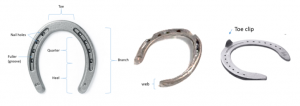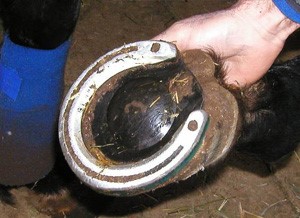Equine podiatry
Shoes and pads – an introduction
Horseshoeing is a very complex topic. This section will just introduce the basics.
Horse shoes
Most shoes are metal (aluminum or steel) but can be plastic, wood or rubber.
Metal shoes can be manufactured in bulk (“keg” shoes due to the original shipping container) or made by hand using a forge.

Shoes are typically designed to protect the foot, enhance the horse’s action, or provide therapeutic support.
Pads
Pads may be added between the shoe and the sole to protect the sole, elevate the heel, prevent snow and ice buildup, change the gait or alter weight bearing. Pads can cover the entire sole (full) or just the outside edges (rim pads). Pads can be flat or wedged.

Shoeing the horse
Shoes can be applied using nails, metal clips and/or glue. Most shoes are applied by farriers. Farriers have different classification levels and can attend school for a few months or several years.
Resources
20 common types of horse shoes
Horseshoe effects on equine gait A systematic scoping review. Vet Surg 54:31-51.
Understanding the basic principles of podiatry, Vet Clin Equine 34 (2018) 391–407- imaging and farrier work
Influence of trimming, hoof angle and shoeing on breakover duration in sound horses examined with hoof-mounted inertial sensors, Vet Rec 2021 – good explanation of breakover and how shoes impact it
Clinical application of the wooden shoe to complement surgical management of laminitis and other foot-related disease in the horse: A report of three cases. Equine Vet Educ. 2023;35:e629–e636. recent article, good reference list for other options
Mechanical Principles of the Equine Foot Vet Clin Equine 37 (2021) 581–618
Used in horses to describe the end of the stance phase: the period of time from when the heel is off the ground to the time when the toe is off the ground. This time window is prolonged with long toes and when a horse is shod. A longer breakover requires more joint motion.

